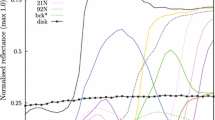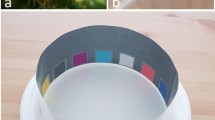Abstract
In melittophilous plants the colour pattern of the flowers, as perceived by bumblebees, is a gradient of centripetally increasing spectral purity. This pattern serves as a signal for innate flower recognition in naive bumblebees permitting orientation to flowers and landing on flowers. Structures which make up the total signal pattern can include the background (e.g., green leaves), corollas, and stamens or floral guides. How various colour parameters, such as dominant wavelength, intensity, and spectral purity influence the colour signal pattern of flowers is analyzed. The process of strong absorption of ultraviolet light is shown to be a mechanism for the enhancement of spectral purity in flower guides. The importance of other mechanisms is also demonstrated. The presence of a gradient of centripetally increasing spectral purity in floral colour patterns as perceived by a bumblebee's eyes is demonstrated by a comparison of the spectral reflectance in different parts of the flower and a representation of colour loci in the colour triangle.
Similar content being viewed by others
References
Backhaus, W., Menzel, R., 1987: Color distance derived from a receptor model of colour vision in the honeybee. — Biol. Cybern.55: 321–331.
Daumer, K., 1956: Reizmetrische Untersuchung des Farbensehens der Bienen. — Z. vergl. Physiol.38: 413–478.
—, 1958: Blumenfarben, wie sie die Bienen sehen. — Z. vergl. Physiol.41: 49–110.
Good, J. A., 1986: Insect visitors toIris pseudacorus (Iridaceae) in Ireland. — Irish Nat. J.22: 71–74.
Guldberg, L. D., Atsatt, P. R., 1975: Frequency of reflection and absorption of ultraviolet light in flowering plants. — Amer. Midl. Naturalist93: 35–43.
Henderson, S. T., 1970: Daylight and its spectrum. — London: Adam Hilger Ltd.
Horovitz, A., Cohen, Y., 1972: Ultraviolet reflectance characteristics in flowers of Crucifers. — Amer. J. Bot.59: 706–713.
Ilse, D., 1949: Colour discrimination in the dronefly,Eristalis tenax. — Nature163: 255–256.
Kevan, P. G., 1979: Vegetation and floral colors revealed by ultraviolet light: interpretational difficulties for functional significance. — Amer. J. Bot.66: 749–751.
—, 1983: Floral colors through the insect eye: What they are and what they mean. — InJones, C. E., Little, R. J., (Eds): Handbook of experimental pollination biology, pp. 3–30. — New York: Van Nostrand Reinold.
Knoll, F., 1922: Der Tierversuch im Dienste der Blütenökologie. — Ber. Deutsch. Bot. Ges.40: 30–40.
—, 1924: Blütenökologie und Sinnesphysiologie der Insekten. — Die Naturwissenschaften12: 988–993.
Kugler, H., 1963: UV-Musterungen auf Blüten und ihr Zustandekommen. — Planta59: 296–329.
—, 1966: UV-Male auf Blüten. — Ber. Deutsch. Bot. Ges.79: 57–70.
Lubliner-Mianowska, K., 1955: The pigments of pollen grains. — Acta Soc. Bot. Polan.24: 609–618.
Lunau, K., 1988a: Attrappenversuche mit blütennaiven Hummeln zum Nachweis angeborener Verhaltensreaktionen auf Blütensignale. — Doctoral thesis, University of Freiburg.
—, 1988b: Angeborenes und erlerntes Verhalten beim Blütenbesuch von Schwebfliegen — Attrappenversuche mitEristalis pertinax (Scopoli) (Diptera, Syrphidae). — Zool. Jahrb. Physiol.92: 487–499.
—, 1990: Colour saturation triggers innate reactions to flower signals: flower dummy experiments with bumblebees. — J. Comp. Physiol. A166: 827–834.
—, 1991: Innate flower recognition in bumblebees (Bombus terrestris, B. lucorum; Apidae): optical signals as landing reaction releasers. — Ethology88: 203–214.
Mazokhin-Porshnyakov, G. A., 1962: Kalorimetrischer Nachweis des trichromatischen Farbensehens bei den Bienenartigen (am Beispiel der Hummel). — Biofizika7: 211–217.
Menzel, R., 1967: Untersuchungen zum Erlernen von Spektralfarben durch die Honigbiene (Apis mellifica). — Z. vergl. Physiol.56: 22–62.
—, 1985: Learning in honeybees in an ecological and behavioral context. — Fortschr. Zool.31: 55–74.
- 1987: Farbensehen blütenbesuchender Insekten. — Jülich: Internationales Büro der Kernforschungsanlage Jülich GmbH (Ed.): 1–15.
—,Backhaus, W., 1991: Colour vision in insects. — InGouras, P., (Ed.): Vision and visual dysfunction. VII, Perception of colour. — London: MacMillan Press.
Neumeyer, C., 1980: Simultaneous color contrast in the honeybee. — J. Comp. Physiol.139: 165–176.
—, 1986: Wavelength discrimination in the goldfish. — J. Comp. Physiol.158: 203–213.
Ornduff, R., Mosquin, T., 1970: Variation in the spectral qualities of flowers in theNymphoides indica complex (Menyanthaceae) and its possible adaptive significance. — Canad. J. Bot.48: 603–605.
Osche, G., 1979: Zur Evolution optischer Signale bei Blütenpflanzen. — Biol. unserer Zeit9: 161–170.
—, 1983: Optische Signale in der Coevolution von Pflanze und Tier. — Ber. Deutsch. Bot. Ges.96: 1–27.
Rosen, D., Barthlott, W., 1991: Ökologische Aspekte der Ultraviolett-Reflexion von Blumen in Mitteleuropa, besonders in der Eifel. — Decheniana (Bonn)144: 72–112.
Silberglied, R. E., 1979: Communication in the ultraviolet. — Annu. Rev. Ecol. Syst.10: 373–398.
Thompson, W. R., Meinwald, J., Aneshansley, D., Eisner, T., 1972: Flavonols: pigments responsible for ultraviolet absorption in nectar guide of flower. — Science177: 528–530.
Utech, F. H., Kawano, S., 1975: Spectral polymorphisms in angiosperm flowers determined by differential ultraviolet reflectance. — Bot. Mag. (Tokyo)88: 9–30.
Author information
Authors and Affiliations
Rights and permissions
About this article
Cite this article
Lunau, K. A new interpretation of flower guide colouration: Absorption of ultraviolet light enhances colour saturation. Pl Syst Evol 183, 51–65 (1992). https://doi.org/10.1007/BF00937735
Received:
Revised:
Accepted:
Issue Date:
DOI: https://doi.org/10.1007/BF00937735




